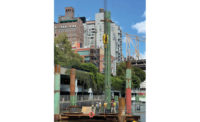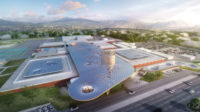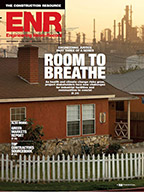The array of green building certifications—such as the LEED rating system, Living Building Challenge, WELL, Envision and Parksmart—provide construction projects with a detailed roadmap to reach sustainability goals. But ENR Top 100 Green Design Firms and Contractors say building to sustainable standards can sometimes be counterintuitive to the traditional process.
Despite a dip last year in green market revenue reported by ranked firms, data collected from the 2021 list participants indicates that sustainability remains a growing priority in construction among owners.
"Water and energy systems, materials science and even landscaping all require technical solutions that our industry possesses,” explains Chris Hellstern, Living Building Challenge services director at Miller Hull Partnership. “Shifting our process to design them in support of natural solutions is the challenge." He terms it a challenge that project stakeholders must be committed to resolve.
“Often we are not prevented by limits of technology but rather human will,” Hellstern says. “In general, the AEC community knows how to design regenerative buildings but we do not always do it.” He adds that while "people are struck by the difficulty of creating projects that meet the Living Building Challenge ... the most important thing we need for these projects to be successful is to have a client who is committed and willing. When we have that, we can design anything for them.”
Setting sustainability goals early helps put project stakeholders on the same page, but Top 100 design firms and contractors point out that some project aspects are often more difficult to "green" than others.
Firms note five key continuing challenges:
1. Recycling Building Materials
Overall, the material recycling market "has taken significant steps backward in recent years,” says Eric Sheffer, principal at SSR. “While not universal, in many cities it has become more difficult to find quality construction/demolition waste recyclers and operational waste recycling.”
As a result, recycling rates have suffered from project construction to the end of its lifecycle, he says. It is a challenge that has brought more attention to the types of building materials used in construction.
“Transparency is still difficult across all building materials,” says Suni Dillard, associate at HMFH Architects Dillard. “We know that materials have an impact at all stages of their lives, but our understanding of this is still limited. We try and simplify what we design and to use products we know aren't harmful. When we can't, for other reasons like durability or whatever else, we limit their use.”
2. Water Saving Systems
Sustainability-focused water saving systems have been “the most difficult part of a project” because clients and architects are challenged to build a “business case” for them, explains Ted Hyman, managing partner at ZGF Architects.
“While projects have been doing a good job at reducing potable water for irrigation and toilet flushing, we need to rethink how all building and site water systems are designed to conserve, harvest, treat, recycle and reuse water to drastically reduce reliance on fresh water,” he says. “We also need to address district-scale water recycling and reuse, which is particularly important in urban areas, where individual buildings likely don’t have the building or site to implement water recycling and reuse strategies.”
In areas where water is seasonally scarce, water-saving systems have the potential to impact entire communities. "This is likely to quickly become an equity issue, where the communities that can afford to import water will maintain their ability to function, while others may need to leave their cities until water supplies are restored," says Hyman.
3. Emergency Power
Even as more buildings switch to electric energy sources, emergency power is often provided from burning fossil fuels in the form of natural gas or diesel fuel. "To eliminate this equipment from the site, alternative strategies such as battery storage or hydrogen fuel cells can be considered, but the financial benefits of newer, clean technologies versus traditional generation is still challenging to prove,” says Jason Fierko, director of energy management at Ewing Cole. “Exploring financial incentives to the maximum extent possible and closely evaluating what must be on emergency power versus what is desired can help improve the financial evaluation by reducing system size and cost.”
He adds that "one way to overcome the financial analysis challenge is to enact policies where carbon 'shadow pricing' is employed to accurately capture the negative impacts of technologies that might otherwise have a lower first cost. This is a powerful tool in capturing carbon considerations in a traditional life cycle cost analysis."
4. Embodied and Operational Waste
Strategies to improve a building's operational resource consumption are often seen as a direct return on investment for designers, says Greg Mella, corporate director of sustainability at SmithGroup, but making the business case for such investments can be challenging.
"Strategies to invest in products with a lower embodied carbon often don’t provide a return on investment and can be harder to convince a client of the direct value in these materials," says Mella. "We’ve found the best way to overcome this challenge is to approach embodied carbon reductions by optimizing design, finding ways to meet programmatic needs by building less. This strategy can take many shapes: adaptively reusing existing buildings, designing spaces that are multi-functioning so smaller buildings can accomplish more, and optimizing structural and building systems to be more efficient using less materials. All of these approaches can save money and save resources.”
Still, even when all technology in a building is new and efficient, its occupants represent a potential unpredictable factor in maintaining operable sustainability.
"From a technology standpoint, we can improve almost everything in a new building," says Narada Golden, vice president and national director at Built Ecology | WSP. "But we also work at the intersection of people and technology—changing how people interact with buildings and technology continues to pose the biggest challenges in achieving net-zero carbon buildings."
Victoria Watson, senior associate of high performance buildings and communities at AECOM, says there is a lot of emphasis on reducing regulated loads (heating, cooling, ventilation, lighting) during design but not enough on monitoring buildings to reduce process and receptacle loads.
“We are increasingly including building analytics platforms in designs to enable collecting, organizing and analyzing operational data to ensure a building is performing as designed and can take advantage of continuous commissioning to stay on track,” she says. “The cheapest kWh is the one not generated at all. Intrinsically, conditioning of buildings requires energy, but there are items of conventional building design that can be challenged to help minimize the demand.”
5. Project Scope
Lastly, when it comes to implementing green building standards, not all projects are equal in being sustainably converted. For this reason, each project must be handled to its specific goals, explains Komal Kotwal, sustainable design leader for HOK's Texas region.
"We need to recognize that there is not a ‘one-size-fits-all’ sustainable solution that can be applied to each project type, location, program and scale," says Kotwal. "Looking at it from the lens of each project is unique, we seek to find the project’s sustainability story that can make the most impact in terms of value to our clients, the environment the project sits on and the people it serves."







Post a comment to this article
Report Abusive Comment